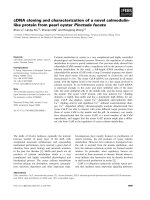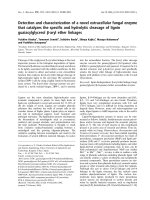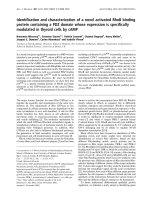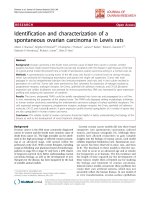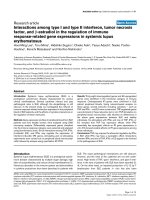Identification and characterization of a novel heart reactive autoantibody in systemic lupus erythematosus possible serological marker for early myocardial dysfunction
Bạn đang xem bản rút gọn của tài liệu. Xem và tải ngay bản đầy đủ của tài liệu tại đây (634.64 KB, 183 trang )
IDENTIFICATION AND CHARACTERIZATION OF A
NOVEL HEART-REACTIVE AUTOANTIBODY IN
SYSTEMIC LUPUS ERYTHEMATOSUS: POSSIBLE
SEROLOGICAL MARKER FOR EARLY
MYOCARDIAL DYSFUNCTION
XU QIAN
NATIONAL UNIVERSITY OF SINGAPORE
2007
IDENTIFICATION AND CHARACTERIZATION OF A
NOVEL HEART-REACTIVE AUTOANTIBODY IN
SYSTEMIC LUPUS ERYTHEMATOSUS: POSSIBLE
SEROLOGICAL MARKER FOR EARLY
MYOCARDIAL DYSFUNCTION
XU QIAN
(M. Med., Shanghai Second Medical University
)
A THESIS SUBMITTED
FOR THE DEGREE OF DOCTOR OF PHILOSOPHY
DEPARTMENT OF MEDICINE
YONG LOO LIN SCHOOL OF MEDICINE
NATIONAL UNIVERSITY OF SINGAPORE
2007
ii
ACKNOWLEDGEMENT
First of all, I would like to express my deepest gratitude and appreciation to my
supervisor Associate Professor Fong Kok Yong, Chairman of Division of
Medicine, senior consultant, Department of Rheumatology and Immunology in
Singapore General Hospital, for his invaluable supervision, support and inspiration.
His open-mindedness, critical comments, provoking discussions as well as
continuous encouragement and patience have enlightened me and inspired my
independent thinking. Apart from these, I have also benefited from his integrity,
preciseness and explorative philosophy to research.
I am also thankful to my co-supervisor Vice-Dean and Associate Professor Koh
Dow Rhoon, Department of Physiology, Yong Loo Lin School of Medicine,
National University of Singapore, for his guidance.
I am also very grateful to Dr Tin Soe Kyaw for his help in my research. His
kindness, patience, and intelligence in research work are very impressive to me.
Thanks to Prof Ling Lieng Hsi and his staff: Ms Yang Hong, Ms Gong lingli for
doing the echocardiography for the patients.
Thanks to Ms Connie Tse, for helping to collect the blood samples and the clinical
data.
Thanks to Dr Sivalingam SP for his humor, kindness, and help.
Thanks to all staff of Deparment of Rheumatology and Immunology, Singapore
General Hospital for their help and friendship.
iii
Thanks to all staff of Department of Clinical Research, Singapore General
Hospital, Dr Aw, Ms Cindy Goh, and the other staff. Thanks for their kind help and
encouragement.
I greatly acknowledge National University of Singapore for offering me the
Research Scholarship and Singapore General Hospital for providing me technical
and research support.
Finally, I would like to give the greatest gratitude to my family for their infinite love
and support. Thanks to my father Mr Xu Houcai, my mother Mrs Xu Wenying,
and my sister Xu xu, for without them, I could not have come so far.
iv
TABLE OF CONTENTS
ACKNOWLEDGEMENTS……………………………………………………….ii
TABLE OF CONTENTS…………………………………………………………iv
SUMMARY………………………………………………………………………ix
LIST OF TABLES……………………………………………………………… xi
LIST OF FIGURES…………………………………………………………… xiii
LIST OF ABBREVIATIONS………………………………………………… xv
LIST OF PUBLICATIONS……………………………………………………xxi
CHAPTER 1 INTRODUCTION
1.1 Systemic lupus erythematosus (SLE) ……………………………………….2
1.1.1 Epidemiology …………………………………………………………….2
1.1.2 Pathogenesis of SLE……………………………………………………….5
1 Genetics……………………………………………………………………5
2 Zero Enviromental factors…………………………………………………… 10
3 Hormones……………………………………………………………… 13
4 Infection and inflammation……………………………………………….14
5 Immunology……………………………………………………… ……17
6 Immune clearance deficiency…………………………………………….20
7 Autoantibodies in SLE……………………………………………………24
8 0 Pathogenesis of cardiovascular involvements in SLE………………… 26
v
1.1.2.8.1 General cardiovascular manifestations in SLE ………………………27
1.1.2.8.2 Factors contributing to cardiovascular disease in SLE……………… 30
1.1.2.8.3 Heart reactive autoantibodies in SLE…………………………………31
1.1.2.8.4 Interleukin-18 and cardiovascular involvements in SLE Therapies for
SLE… ………………………………………………………………37
1.2 Diagnostic approaches of cardiovascular involvements in SLE…………….39
1.2.1 Echocardiography……………………………………………………… 40
1.2.1.1 Transthoracic echocardiography (TTE) and Transesophageal
echocardiography (TEE)…………………………………………………………40
1.2.1.2 Myocardial contrast echocardiography………………………………… 42
1.2.1.3 Doppler Tissue Imaging (TDI)………………………………………… 43
1.2.1.4 Strain and Strain Rate…………………………………………………….45
1.2.2Cardiac troponin I.………………………………………………………… 48
1.3 Gaps………………………………………………………………………… 52
1.4 Objectives of the study…………………………………………………… 52
CHAPTER 2 MATERIALS AND METHODS
2.1 Heart reactive autoantibodies study………………………….……………….55
2.1.1 Recruitment of patients and controls and collection of clinical data……….55
2.1.2 Sources of organ samples …………………………………………………56
2.1.3 Membrane protein extraction……………………………………………….57
2.1.4 Immunoblotting…………………………………………………………….57
vi
2.1.5 Detection of heart reactive autoantibody (HRAA)…………………………59
2.1.6 Two-dimensional (2-D) gel electrophoresis……………………………… 59
2.1.7 Peptide mass fingerprinting……………………………………………… 60
2.1.8 Calculation of molecular weights……………… …………………………61
2.1.9 Characterisation of the HRAA protein…………… ………… ………… 61
2.1.9.1 Western blot comparations between lupus serum and troponin antibodies.61
2.1.9.2 Immunoprecipitation…………………………………………………… 62
2.1.9.3 Competitive binding by human cardiac troponin I proteins…………… 62
2.1.10 Statistics………………………………………………………………… 63
2.2 Echocardiography…………………………………………………………….63
2.2.1 Patients…………………………………………………………………… 63
2.2.2 Echocardiography……………… …………………………………………64
2.2.3 Doppler tissue imaging and strain rates measurements…………………….65
2.2.4 Statistics…………………………………………………………………….65
2.3 Interleukin 18 and cardiac involvements in SLE…………………………… 65
2.3.1 Patients recruitment and sample preparation ………………………………65
2.3.2 Genomic DNA extraction………………………………………………… 66
2.3.3 Specific Sequence Primer PCR…………………………………………… 66
2.3.4 Restriction Fragment Length Polymorphisms (RFLP) analysis………… 67
2.3.5 Enzyme-linked immunosorbent assay (ELISA) for circulating interleukin 18
levels in SLE patients……………………………………………………….67
2.3.6 Statistics…………………………………………………………………….68
vii
CHAPTER 3 RESULTS
3.1 Patient demographics… …………………………………………………… 70
3.2 Prevalence of HRAA in lupus patients, non-lupus patients and healthy
controls………………………………………………………………… … 72
3.3 Tissue and species specificity of HRAA…………………………………… 76
3.4 Peptide mass fingerprinting of heart antigens reactive to HRAA…………….78
3.5 Confirmation of cardiac troponin I……………………………………………79
3.5.1 Comparision of the western blotting images……………………………… 79
3.5.2 Immunoprecipitation……………………………………………………….80
3.5.3 Competitive western blotting……………………………………………….82
3.6 Echocardiography…………………………………………………………….83
3.7 Interleukin 18 results………………………………………………………….89
3.7.1 Clinical data……………………………………………………………… 89
3.7.2 Allelic frequencies of Interleukin 18 promoter gene polymophisms at position
-607 and -137 in SLE patients and controls……………………………… 89
3.7.3 Genotypic frequencies of Interleukin 18 promoter gene polymorphisms at
position -607 and -137 in SLE patients and controls……………………….90
3.7.4 Correlation of Interleukin 18 promoter gene polymorphism and circulating
Interleukin 18 protein levels……………………………………………… 93
3.7.5 Patients with HRAA have higher circulating Interleukin 18 levels.……… 96
CHAPTER 4 DISCUSSION………… …………………………………………97
viii
CHAPTER 5 CONCLUSION… …………………………………………… 112
REFERENCES… …………………………………………………………… 114
APPENDICES………………………………………………………………… 158
ix
SUMMARY
Early cardiac involvement is difficult to diagnose in SLE. Autoantibodies have
been associated with lupus cardiac involvement. A novel 29-kDa heart reactive
autoantibody was identified in lupus sera by immunoblots, and characterized as
anti-cTnI (cardiac troponin I) antibody by 2-D electrophoresis and mass
spectrophotometry of the mouse heart antigen. This was further confirmed by
competitive inhibition assays. The prevalence of this antibody was found to be 12%
in a cohort of 109 lupus patients. Immunoblotting results using human heart lysates
showed concordant results with those obtained by mouse heart lysates. No
anti-cTnI was detected in the sera of 118 non-lupus rheumatic patients (primary
antiphospholipid syndrome, rheumatoid arthritis, osteoarthritis, polymyositis) and
50 patients with acute myocardial infarction. Polymyositis patients and lupus
patients with myositis showed a positive protein band of 27 kDa, which was
demonstrated to be similar to skeletal TnI. Clinical data were obtained by chart
review. Color Doppler echocardiography with measurements of strain and strain
rates were performed to evaluate cardiac function in the same cohort of lupus
patients. Anti-cTnI positivity was found to correlate with myocardial dysfunction
as shown by reduced early diastolic longitudinal strain rates. I postulate that the
formation of anti-cTnI antibody is the result of chronic, low-grade cardiomyocyte
damage and may represent sustained early cardiac damage. This antibody may
serve as an early serological marker for cardiac involvement in lupus patients.
In this study, I also describe the Interleukin 18 (IL-18) promoter gene
x
polymorphisms in a cohort of Chinese SLE patients and the protein levels in the
circulation. Two single nucleotide polymorphisms at position –607 and –137 of the
interleukin 18 promoter gene were studied. I found the frequency of genotype
SNP-607/CC, to be significantly higher in Chinese SLE patients when compared to
the control individuals. A significant decrease of genotype AC at position –607 was
also observed in SLE patients compare to the controls. This study also shows that
SLE patients have significantly higher circulating IL-18 protein levels than normal
controls. The results also indicate that patients who have anti-cTnI antibody may
have higher circulating IL-18 proteins.
These findings not only suggest a possible mechanism for cardiac damage in SLE
patients, but also provide a possible early serological marker for lupus cardiac
involvements.
xi
LIST OF TABLES
Table 1. Environmental factors and SLE. Adapted from "Environment and
systemic lupus erythematosus: an overview."(Sarzi-Puttini et al. 2005) 12
Table 2. Possible Factors contributing to cardiovascular disease in SLE 31
Table 3. Demographic data of controls, lupus and non-lupus patient cohort. 71
Table 4. ACR criteria presentation of lupus patients at diagnosis (n=109) 72
Table 5. HRAA in controls, lupus and non-lupus groups 73
Table 6. Demographic data of HRAA -positive and -negative groups 74
Table 7. Autoantibody profiles of SLE patients positive and negative for HRAA
75
Table 8: Distribution of heart-related disease in SLE patients positive and negative
for HRAA 75
Table 9. M-mode, two-dimensional, conventional Doppler and annular tissue
velocity echocardiographic variables in SLE patients with and without
anti-cTnI
84
Table 10. Longitudinal (Longit) and radial myocardial tissue velocity, strain rate
and strain indexes in SLE patients with and without anti-cTnI
86
Table 11. Correlation of longitudinal strain rates with Anti-cTnI
87
Table 12. Valvular thickening and regurgitation in SLE patients according to
anti-cTnI status
88
Table 13. Allelic frequencies of IL-18 promoter gene polymorphisms at
position-607 and –137 in SLE patients and controls 90
xii
Table 14. Genotypic frequencies of IL-18 promoter gene polymorphisms at
positions -607 and -137 in SLE patients and controls. 92
Table 15. Expected genotypic frequencies of both SNPs based on Hardy-Weinberg
equilibrium 92
Table 16. Correlation between SNP-607 genotypes and plasma IL-18 protein
concentrations 93
xiii
LIST OF FIGURES
Figure 1: The role of environment in SLE. Adapted from “Environment and
systemic lupus erythematosus: an overview.” (Sarzi-Puttini et al. 2005). 13
Figure 2: Roadmap to disease development and progression in SLE 18
Figure 3. Schematic illustrating concept of strain and strain rate (SR). Adapted from
"Clinical applications of strain rate imaging." (Yip et al. 2003) 46
Figure 4. Example of strain rate (SR) image. Adapted from "Clinical applications
of strain rate imaging." (Yip et al. 2003) 48
Figure 5. Identification of Heart Reactive Autoantibody (HRAA) 73
Figure 6. The HRAA is heart-specific. 76
Figure 7. Immunoblotting results of HRAA against heart membrane protein
extracted from different species 77
Figure 8. Two dimensional electrophoresis detection of mouse heart membrane
proteins recognized by systemic lupus erythematosus patient’s serum. 78
Figure 9. Serial immunoblots using varying anti-cTnI antibodies and lupus sera
dilutions 79
Figure 10. Immunoblots showing bands indicate presence of anti-cardiac TnI (cTnI)
and skeletal TnI (sTnI) in lupus and polymyositis patients.
80
Figure 11. Immunoprecipitation of the mouse heart proteins using antibody against
cardiac Troponin I (cTnI)
81
Figure 12. Competitive western blotting. 82
Figure 13. Correlation between SNP-607 genotypes and IL-18 plasma protein
xiv
concentrations in SLE patients 94
Figure 14. Correlation between SNP-607 genotypes and IL-18 plasma protein
concentrations in normal controls 95
Figure 15. Plasma IL-18 protein levels in SLE patients. 96
xv
LIST OF ABBREVIATIONS
ACA anticardiolipin antibodies
ACR American College of Rheumatology
ACHA anticholesterol antibody
aCL anticardiolipin antibodies
ANA antinuclear autoantibody
ANP atrial natriuretic peptide
APS anti-phospholipid syndrome
aPL anti-phospholipids antibodies
ARA American Rheumatology Association
ATP adenosine triphosphate
BCIP 5-Bromo-4-Chloro-3'-Indolyphosphate
p-Toluidine
BMI body mass index
cAMP cyclic adenosine monophosphate
CAD coronary artery disease
CHB congenital heart block
CHAPS 3-[(3-Cholamidopropyl)
dimethylammonio]-1- propanesulfonate
CHCA Alpha-Cyano-4-Hydroxycinnamic Acid
CK-MB creatine kinase MB fraction
xvi
CNS central nervous system
CREB cAMP-responsive element binding
CRP C-reactive protein
CS cumulative corticosteroid
cTnI cardiac troponin I
cTn T cardiac troponin T
DCM dilated cardiomyopathies
DBP diastolic blood pressure
DHB 2,5-dihydroxybenzoic acid
DNA deoxyribonucleic acid
DT deceleration time of mitral inflow
DTI Doppler tissue imaging
DTT Dithiothreitol
EAM experimental autoimmune myocarditis
EBV Epstein-Barr virus
EF ejection fraction
ELISA Enzyme-linked immunosorbent assay
F/M female/ male
GM-CSF granulocyte macrophage
colony-stimulating factor
GnRH gonadotropin releasing hormone
HRAA heart reactive autoantibodies
xvii
HLA human leukocyte antigen
HSP heat shock protein
ICAM intercellular adhesion molecule
IIM idiopathic inflammatory myopathies
IFN interferon
IgG Immunoglobulin G
IgA Immunoglobulin A
IgM Immunoglobulin M
IL interleukin
IRAP idiopathic recurrent acute pericarditis
IVRT isovolumic relaxation time derived from
Doppler tissue imaging
IVS wall thickness of intraventricular septum
kDa kilo Dalton
LA left atrium
LDL low density lipoprotein
LV left ventricle
LVIDd left ventricular end-diastolic dimension
LVIDs left ventricular end-systolic dimension
MALDI-TOF-MS matrix-assisted laser desorption ionization-
Time of Flight - Mass Spectrometry
MBP mannose binding protein
xviii
MCE myocardial contrast echocardiography
MCTD mixed connective tissue disease
MHC major histocompatibility complex
Mitral A peak velocity of late diastolic mitral inflow
Mitral E peak velocity of early diastolic mitral
inflow
MS mass spectrometry
NBT Nitro-Blue Tetrazolium Chloride
NCBI National Center for Biotechnology
Information
NK nature killer T cell
NSAIDS non-steroidal anti-inflammatory drugs
NZB/W New Zealand Black/White mice
oxLDL oxidized low-density lipoprotein
OA osteoarthritis
PAPS primary antiphospholipid syndrome
PASP pulmonary artery systolic pressure
PBS phosphate buffered saline
PCNA Proliferating Cell Nuclear Antigen
PCR polymerase chain reaction
PDK1 phosphoinositide-dependent kinase-1
PI3K phosphatidylinositol 3-kinase
xix
pSS primary sjögren’s syndrome
ra right atrium
RA Rheumatoid Arthritis
RF rheumatic fever
RFLP restricted fragment length polymorphisms
RNA ribonucleic acid
RNP ribonucleoprotein
RV right ventricle
SBP systolic blood pressure
SDS-PAGE sodium dodecyl sulphate-polyacrylamide
gel electrophoreses
SNP single nucleotide polymorphism
SLE systemic lupus erythematosus
SR strain rate
Sm Smith
TBS-T Tris Buffered Saline buffer with tween 20
TCR T cell receptor
TEE transesophageal echocardiography
TEMED N,N,N',N'- tetramethylethylendiamin
Tris 2-amino-2-(hydroxymethyl)-1,3-propanediol
TNF tumor necrosis factor
TTE transthoracic echocardiography
xx
UK United Kingdom
USA Unite States of America
VDRL venereal disease reference laboratory
xxi
LIST OF PUBLICATIONS
Tin SK, Xu Q, Thumboo J, Lee LY, Tse C, Fong KY. Novel brain reactive
autoantibodies: prevalence in systemic lupus erythematosus and association with
psychoses and seizures. J Neuroimmunol. 2005 Dec;169(1-2):153-60
Xu Q, Tin SK, Sivalingam SP, Thumboo J, Koh DR, Fong KY. Interleukin-18
promoter gene polymorphisms in Chinese patients with systemic lupus
erythematosus: Association with CC genotype at position -607. Ann Acad Med
Singapore. 2007 Feb;36(2):91-5
Presentations:
Xu Q, Tin SK, Sivalingam SP, Thumboo J, Koh DR, Fong KY. Interleukin-18
promoter gene polymorphisms in Chinese patients with systemic lupus
erythematosus: Association with CC genotype at position –607. Poster presentation
at World Inflammation Conference 2005. August, 2005, Melbourne.
Xu Q, Tin SK, Thumboo J, Fong KY. Enhanced production of Interleukin 18
protein is associated with SNP -607 C allele in normal individuals and systemic
lupus erythematosus. Poster presentation at World Inflammation Conference 2005.
August, 2005, Melbourne.
xxii
Xu Q, Tin SK, Thumboo J, Fong KY. Prevalence of heart reactive autoantibodies
(HRAA) in systemic lupus erythematosus patients. Poster presentation at
Combined Scientific Meeting Singapore 2005. September, 2005, Singapore.
Xu Q, Tin SK, Sivalingam SP, Thumboo J, Koh DR, Fong KY. Interleukin-18
promoter gene polymorphisms in chinese patients with systemic lupus
erythematosus: association with CC genotype at position -607. Poster presentation
at singhealth scientific meeting 2004. October 2004, Singapore.
Manuscript:
Xu Q, Ling LH, Thumboo J, Tin SK, Chua T, Tse C, Yang H, Fong KY.
Identification and characterization of a novel heart-reactive autoantibody in
systemic lupus eryhematosus and correlation with Doppler myocardial strain rates:
possible serological marker for early myocardial dysfunction.
1
CHAPTER 1
INTRODUCTION
Introduction
2
1.1 Systemic lupus erythematosus
Systemic lupus erythematosus (SLE) is a multi-organ autoimmune disease
characterized by a wide array of clinical manifestations, from mild skin and
mucosal lesions to severe inflammation in the central nervous system, kidneys and
other organs. It involves almost every aspect of immunology and is thought to be
the archetype of autoimmune diseases. SLE is a very heterogeneous disease, but
most of its diverse manifestations, including glomerulonephritis, cytopenias, rashes
and thromboses, are driven by the production of autoantibodies. The overall disease
prevalence 1.5–250 in 100,000 (Rus and Hochberg 2002) and until the middle of
the last century, the 5-year survival rate was < 50% (Dubois and Wallace 1987).
1.1.1 Epidemiology
Epidemiological studies on SLE show marked gender, age, racial, temporal and
regional variations, indicating hormonal, genetic and environmental factors are
disease triggers.
Firstly, there are striking gender disparities in SLE. Higher disease prevalence in
women was found compared to men. Based on clinical experiences alone, it was
established that the disease generally affected females in 80–90% of the cases
(Siegel and Lee 1973). In a more recent review, the female-to-male ratio in the
childbearing years was reported to be about 12: 1 (Ramsey-Goldman R 2000).
These observations suggest that hormonal factors play important roles in SLE
pathogenesis.
